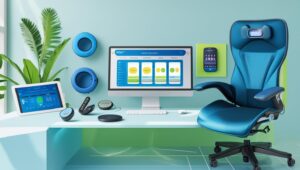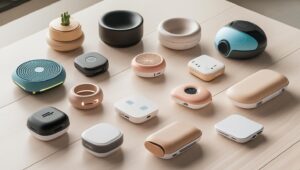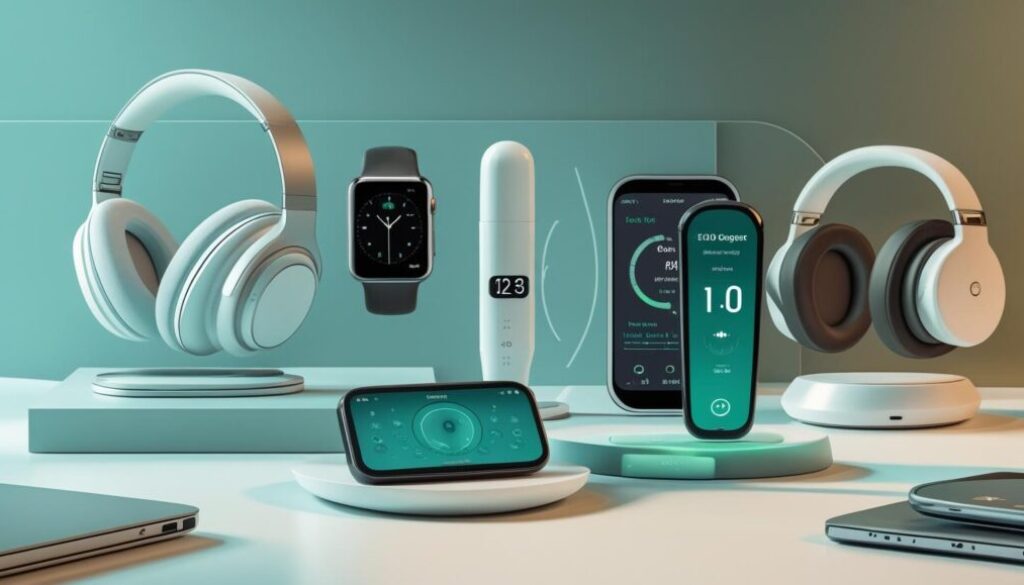10 Game-Changing ADHD Therapy Gadgets for Better Focus and Efficiency
Introduction
Living with ADHD can make focusing and staying productive feel like an ongoing struggle. Whether you’re managing ADHD yourself or supporting someone who does, finding effective strategies to improve focus and productivity is essential. One of the most helpful ways to tackle ADHD-related challenges is by incorporating specialized therapy tools and gadgets into daily routines. These tools can provide structure, reduce distractions, and support cognitive functions that help with task completion and time management. In this post, we’ll explore the top 10 ADHD therapy tools and gadgets that have proven to boost focus and productivity. From fidget toys that calm restlessness to time management apps that keep you on track, these solutions cater to both children and adults. Whether you’re looking to enhance concentration or streamline your organization, these tools are designed to make managing ADHD more manageable and effective, offering a combination of practical and therapeutic benefits.
1. Understanding ADHD and Its Symptoms
ADHD (Attention-Deficit/Hyperactivity Disorder) is characterized by a range of symptoms that impact daily functioning. Common signs include persistent inattention, such as difficulty focusing, following through on tasks, or staying organized. Impulsivity is another key symptom, leading to hasty decisions or difficulty waiting turns. Hyperactivity, like restlessness or excessive talking, is also prevalent. These symptoms can vary between individuals, making it challenging to manage daily responsibilities at work, school, or in personal life, affecting productivity and relationships.
ADHD symptoms, such as difficulty focusing, impulsivity, and disorganization, can significantly disrupt daily life. Individuals may struggle to complete tasks on time, maintain relationships, and manage responsibilities. These challenges often result in frustration, low self-esteem, and a sense of being overwhelmed, making it difficult to reach full potential.
Therapy tools and gadgets play a crucial role in managing ADHD symptoms by providing structured support. They help improve focus, reduce impulsivity, and promote emotional regulation. Whether it’s through physical gadgets like fidget toys or digital tools like productivity apps, these resources can enhance therapy outcomes and daily functioning.

2. Criteria for Choosing ADHD Therapy Tools and Gadgets
When choosing ADHD therapy tools and gadgets, it’s crucial to assess their effectiveness in addressing specific symptoms like poor focus, impulsivity, and disorganization. The best tools actively support individuals by helping to improve attention span, reduce distractions, and promote better time management, enhancing daily functioning.
If you are considering choosing ADHD therapy tools and gadgets, ease of use is crucial. Products should be intuitive, simple to integrate into daily life, and require minimal effort to operate. Accessibility, including affordability and availability, is also important to ensure that users can consistently incorporate these tools into their routines.
When choosing ADHD therapy tools, it’s essential to consider how well they integrate with your existing treatment plan and lifestyle. Tools should complement therapy approaches, whether cognitive behavioral therapy (CBT), coaching, or medication. They should also fit seamlessly into daily routines, supporting long-term consistency and ensuring ease of use for maximum effectiveness in managing symptoms.
When selecting ADHD therapy tools and gadgets, it’s important to consider expert recommendations and user reviews. Insights from therapists, ADHD coaches, and medical professionals can guide your choices, while user feedback offers real-world experiences. Combining both ensures you select the most effective, trusted tools for managing ADHD.
3. The Top 10 ADHD Therapy Tools and Gadgets
Fidget Toys
- Fidget toys, such as fidget spinners, cubes, and other tactile objects, are simple yet effective tools for managing ADHD symptoms like restlessness and impulsivity. These toys provide sensory stimulation that can help individuals focus by redirecting excess energy. The repetitive motion and tactile feedback help calm the mind, making it easier to concentrate on tasks. Fidget toys are particularly beneficial in high-stress or distracting environments, offering a discreet and portable solution to maintain focus throughout the day.
- Fidget Cubes– https://amzn.to/41QkIcn
- Spiky Rings– https://amzn.to/3CF7ULi
- Bouncy Bands– https://amzn.to/3Zi0q9J
Focus-Boosting Apps
- Focus-boosting apps are a game changer for individuals with ADHD, offering practical solutions to improve concentration and minimize distractions. These apps are designed to help users stay on track by promoting deep work and managing time effectively. One of the most popular methods is the Pomodoro Technique, which involves working in short bursts followed by brief breaks. Apps like Forest and Focus@Will integrate this technique to create an environment that enhances productivity. Forest, for example, encourages users to grow a virtual tree while focusing, with the tree thriving only if the user stays off their phone. Focus@Will provides background music scientifically designed to boost attention and block out distractions.
- Other apps like RescueTime track how you spend your time and help identify areas where distractions occur, while Cold Turkey and Freedom block distracting websites to help you stay on task. By combining structured work periods with distractions blockers, focus-boosting apps can significantly improve productivity for those managing ADHD.
Timer/Time Management Gadgets
- Timer and time management gadgets are essential tools for individuals with ADHD, as they help manage distractions and improve focus. People with ADHD often struggle with time blindness, where they lose track of time or feel overwhelmed by tasks. A visual timer, such as the Time Timer, can be a game-changer, providing a clear visual countdown that helps individuals stay on track and manage their time more effectively. These timers are especially useful for breaking tasks into smaller, more manageable chunks, like the Pomodoro technique, which involves working for 25 minutes followed by a short break.
Time Timer– https://amzn.to/4eH0RyU
- In addition to physical timers, there are a variety of digital tools and apps that cater to ADHD needs. For example, apps like Be Focused and Toggl can help track time and set reminders, making it easier to prioritize tasks and stay focused. These time management gadgets provide structure, reduce anxiety, and enhance productivity by offering clear time boundaries and encouraging consistent breaks.

Noise-Canceling Headphones
- Noise-canceling headphones are an invaluable tool for individuals with ADHD, as they help reduce auditory distractions, which can significantly hinder focus and productivity. People with ADHD often struggle with sensory overload, especially in noisy environments, making it difficult to concentrate on tasks. Noise-canceling headphones work by using advanced technology to block out background sounds, creating a quieter, more controlled environment. This allows individuals to focus better, whether they’re working, studying, or simply trying to relax.
- These headphones are particularly beneficial for individuals who work in open-plan offices, attend noisy classrooms, or live in bustling households. By reducing external noise, they help minimize distractions and promote sustained concentration. Additionally, many models come with features like adjustable sound settings, Bluetooth connectivity, and built-in microphones for calls or virtual meetings. For anyone with ADHD, investing in high-quality noise-canceling headphones can make a significant difference in creating a productive and calm space.
Noise Cancelling Headphones– https://amzn.to/4ga2DtJ

Organizational Planners and Journals
- Organizational planners and journals are essential tools for individuals with ADHD, helping to manage time, tasks, and goals more effectively. People with ADHD often struggle with organization, forgetfulness, and task prioritization, making it challenging to stay on top of daily responsibilities. A well-designed planner or journal can provide the structure needed to navigate these obstacles.
- ADHD-specific planners, like the Panda Planner or Passion Planner, are tailored to help users break down their day into manageable sections. These planners often include features such as goal-setting, time-blocking, and daily reflections, which can help improve focus and track progress. Journals, particularly those designed for ADHD, provide a space for individuals to jot down thoughts, ideas, and reminders, promoting mindfulness and reducing mental clutter.
Panda Planner– https://amzn.to/3CFhj5A
- By using organizational planners and journals, individuals with ADHD can better visualize their tasks, stay organized, and improve overall productivity, creating a sense of accomplishment and reducing feelings of overwhelm.
Interactive Smart Pens
- Interactive smart pens are a game-changer for individuals with ADHD, particularly when it comes to note-taking, memory retention, and organization. These high-tech pens, such as the Livescribe Smart Pen, allow users to write on special paper while simultaneously recording audio, syncing both the written notes and audio in real-time. This feature is especially helpful for those who struggle with retaining information or focusing during lectures, meetings, or therapy sessions.
Interactive Pen– https://amzn.to/3Zh0rL3
- With smart pens, users can later review their notes, replay audio segments, or even convert handwritten notes into digital text. This technology enhances focus by reducing the need to multitask, as the pen captures everything that’s spoken and written, allowing the user to concentrate on listening or engaging with the material.
- Smart pens also help individuals with ADHD stay organized, keeping all their notes in one digital format. This makes them an excellent tool for students, professionals, and anyone looking to boost their productivity and retention.
Brainwave-Training Devices (Neurofeedback)
- Neurofeedback is an innovative approach that uses brainwave-training devices to help individuals with ADHD improve focus and self-regulation. These devices monitor brain activity in real-time, providing feedback to the user, allowing them to train their brain to function more effectively. By using sensors placed on the scalp, the device measures electrical activity and helps the user learn to adjust their brainwaves to a more balanced state.
- For individuals with ADHD, this training can help increase attention, reduce impulsivity, and improve emotional regulation. Devices like Muse and FocusBand are examples of wearable neurofeedback tools that provide gentle guidance and rewards when the brain enters the desired state, making the process engaging and interactive. Neurofeedback can be particularly useful for those who struggle with traditional therapies or prefer non-invasive methods. While the devices can be used at home, professional guidance can enhance their effectiveness for managing ADHD symptoms.
Muse Device– https://amzn.to/3CHadO0
Stress-Relief Gadgets (e.g., stress balls, breathing devices)
- Stress-relief gadgets play a crucial role in managing ADHD symptoms, as they help calm the mind and body, which can often feel overwhelmed by constant stimulation. For many people with ADHD, stress and anxiety are common co-occurring conditions that can further disrupt focus and productivity. Stress-relief gadgets, such as stress balls, fidget spinners, and breathing devices, can provide immediate relief by offering a physical outlet for nervous energy, promoting relaxation, and encouraging mindfulness.
- Stress balls, for instance, provide a simple but effective way to release tension. Squeezing them can help reduce anxiety and improve concentration by channeling excess energy into a calming physical activity. Breathing devices like the Breath Buddy or Spire Stone guide deep breathing exercises that help regulate the nervous system, reduce stress levels, and increase focus. These tools are easy to use and portable, making them ideal for use at home, work, or school to maintain calm and enhance productivity.
Spire Stone- https://amzn.to/3V9XKbK
Smart Watches for Reminders and Alerts
- Smartwatches have become a valuable tool for managing ADHD, especially when it comes to reminders and alerts. Individuals with ADHD often struggle with time management, forgetfulness, and staying on task, which can disrupt their daily routines. A smartwatch, like the Apple Watch or Fitbit, can provide a constant, discreet reminder system that helps keep track of appointments, tasks, and even medications. With customizable alerts, users can set reminders for important activities or break tasks into smaller, manageable steps, which helps reduce overwhelm. Many smartwatches also offer features like calendar syncing, to-do lists, and vibration alerts that gently prompt users without adding more mental clutter. Additionally, smartwatches can track health-related metrics, such as sleep and activity levels, which are essential for managing ADHD. By offering real-time notifications and organizing schedules, these devices can significantly improve productivity and reduce forgetfulness, making them an indispensable tool for ADHD management.

4. How to Choose the Right ADHD Therapy Tools for You
Choosing the right ADHD therapy tools depends on a variety of factors, as each individual experiences ADHD symptoms differently. To start, consider your specific challenges—whether it’s difficulty focusing, staying organized, managing time, or regulating emotions. Identifying the areas where you need the most support will guide your selection of tools. For instance, if you struggle with staying on task, a time management tool like a visual timer or an app that uses the Pomodoro technique may be helpful. On the other hand, if impulse control or emotional regulation is a challenge, tools like stress-relief gadgets or mindfulness apps might be more effective.
Next, consider your lifestyle and preferences. Some tools work best in specific settings, like using a noise-canceling headset at work or a weighted blanket at home for relaxation. Age and cognitive development also play a role—tools designed for children, such as fidget toys or ADHD planners, may differ from those suited for adults, who might benefit from more sophisticated organizational tools or focus-enhancing apps.
Finally, budget is an important consideration. Many helpful ADHD tools, such as planners or fidget gadgets, are affordable, while others, like neurofeedback devices, can be costly. Choose tools that fit your needs and budget while complementing your ADHD treatment plan.
5: Additional Tips for Maximizing the Effectiveness of ADHD Therapy Tools
To get the most out of ADHD therapy tools, it’s important to incorporate them into a consistent daily routine. Start by setting clear, achievable goals and using the tools to track progress. Whether you’re using a time management app or a planner, make sure to review your tasks and accomplishments regularly to stay motivated. Combine multiple tools for a holistic approach – for example, pair a fidget toy with a focus-boosting app or a weighted blanket with a mindfulness practice. Establishing routines is key to reducing ADHD symptoms, so try to use your tools at the same time each day for consistency.
Another helpful tip is to create an environment that minimizes distractions. For example, noise-canceling headphones or a designated quiet space can make a big difference in maintaining focus. Lastly, remember that ADHD therapy tools work best when paired with professional support, such as therapy or coaching, to provide ongoing guidance and personalized strategies.
Conclusion
In conclusion, the right ADHD therapy tools and gadgets can make a significant difference in managing symptoms and boosting focus and productivity. From fidget toys that help alleviate restlessness to specialized apps and smart devices that improve time management and concentration, there’s a wide variety of options to suit different needs. Whether you’re looking for solutions to enhance focus, reduce distractions, or organize tasks more effectively, these tools can be a game-changer. By incorporating the right gadgets into your daily routine, you can complement therapy and create a more structured, productive environment. Remember, the key is finding what works best for you—experimenting with different tools and consistently using them to build positive habits. Ultimately, the right ADHD tools can empower you to take control of your symptoms and unlock your full potential, both at home and in professional settings.





